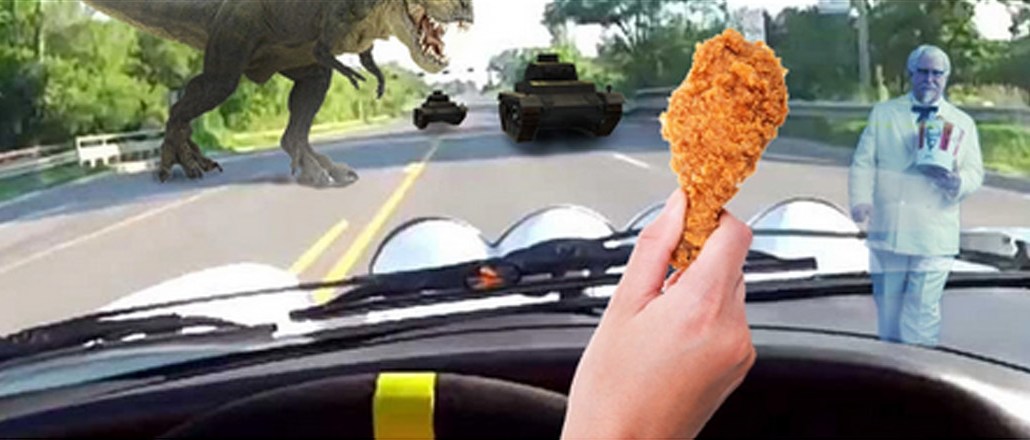Save 50% on a 3-month Digiday+ membership. Ends Dec 5.
Tanks, chicken, dinosaurs, and blink to buy: What’s down the road for native

The future is here. Well, almost.
Native advertising has staked its claim in the digital ecosystem. But as the Internet of Things becomes less of a pipe dream and more of our (augmented) reality, the number of platforms and settings for native ads and sponsored content is about to explode.
To find out what that means for the consumer experience, we talked to Adam Kleinberg, designer and CEO of the Bay Area agency Traction. From ad-serving fridges to virtual reality, he paints a picture of marketing’s future that’s sunny, but cautious.
Consumers are finally getting comfortable with wearables. What will native advertising look like in that context?
Virtual reality is going to come to play a bigger role. I can envision a world where the next version of Google Glass has virtual reality capabilities embedded in it that could provide a whole rich new array of marketing opportunities.
You could look at a store and you could see an ad right in front of that store. Or you could look at your shoes and see what a pair of Nikes would look like and have an offer so that you could blink to buy. The potential of the future is limitless as far as the imagination goes, and it sounds futuristic to say that, but it’s not. The future is five years away.
“Blink to buy” sounds like a recipe for disaster. I don’t want to accidentally buy a copier or a watercooler or something just because I blinked at it.
There’s going to be some sort of syntax that emerges. For instance, the average person blinks 15 to 20 times every minute, so it would need to be a thing where you blink in a certain way — like for a second. Regardless, we’re going to need an undo gesture.
Even cars are more connected now. What’s native to driving other than radio?
I think smart cars are going to be a real delicate area because of the danger that’s posed when people use technology while they’re driving. We’re seeing AT&T spending millions of dollars to get people to not use their products when they drive. Because they die… You mess up the experience of delivering advertising in a car and people die.
Ad position: web_incontent_pos1
But self-driving cars are right around the bend. Consumers will potentially sit for hours while commuting. Doesn’t that make them prime targets for advertising?
For sure. And that marketing will become smarter. There’ll be the same retargeting and contextual relevance. They’ll know if you’re likely to be a fast-food breakfast consumer and serve you ads in the morning for it. They’ll know if it’s raining in your geography and send you ads to go to Hawaii or to buy an umbrella.
What’s the self-driving car experience going to look like when it comes to ads?
I could easily envision a virtual reality console on my dashboard so it looked like there were dinosaurs or enemy tanks on the road as I un-drive myself to work. Maybe the Colonel [Sanders, of KFC] could virtually walk out in the middle of the game and give me a virtual chicken leg I could use to whack enemy soldiers in the head with.
So native’s going to be even more reliant on context.
It’s going to be that additional layer of data. The whole idea behind the Internet of Things is that everything can become a channel. Your refrigerator could be a channel that becomes contextually aware of when you’re out of butter and then serves you an ad to buy more butter.
Are consumers going to be creeped out when appliances (and thus brands) are so aware of their habits?
I don’t think so. As the future comes younger people are going to become older people, and younger people don’t give a shit.
So about that “smart fridge”: What’s the interface like?
I’d have an LCD screen, like an iPad, with a pre-installed app. […] That would give you contextual knowledge of what you need, but also cost-saving alternatives. If I’m out of Land O’Lakes butter, could they give me a coupon for some other butter? If I’m out of Jiffy peanut butter, could they give me a coupon for Peter Pan?
Ad position: web_incontent_pos2
Kind of a slippery slope. Can native enter the bedroom?
Of course it could. We’re selling cat litter online […] Once people start buying online they like the convenience of a product like that just showing up once a month. They can just go and reorder in two clicks whenever they’re done with their box. That box could be a box of rubbers, I guess. It would be amazing to have that connected to your Nike Band, and it senses when you have an orgasm and sends you a new box of condoms.
The future is limitless.
Yeah, absolutely.
More from Digiday

Ulta, Best Buy and Adidas dominate AI holiday shopping mentions
The brands that are seeing the biggest boost from this shift in consumer behavior are some of the biggest retailers.

Digiday+ Research Subscription Index 2025: Subscription strategies from Bloomberg, The New York Times, Vox and others
Digiday’s third annual Subscription Index examines and measures publishers’ subscription strategies to identify common approaches and key tactics among Bloomberg, The New York Times, Vox and others.

U.K. retailer Boots leads brand efforts to invest in ad creative’s data layer
For media dollars to make an impact, brands need ad creative that actually hits. More CMOs are investing in pre- and post-flight measurement.
Ad position: web_bfu
